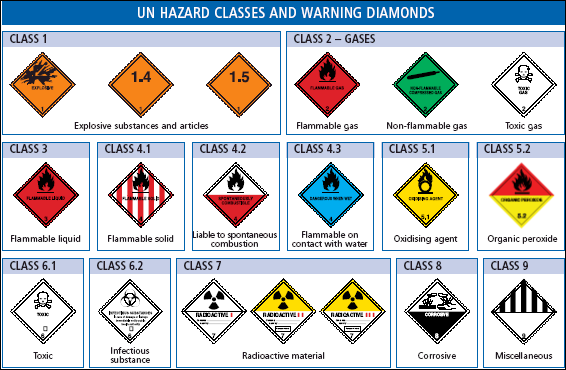Classifications
The International Maritime Dangerous Goods (IMDG) Code classifies dangerous goods into a total of nine hazard classes, each representing a different type of hazard associated with these materials. These hazard classes are used to categorize and classify dangerous goods based on their primary hazards. Here are the nine hazard classes in the IMDG Code:
1. Hazard Class 1: Explosives:
This class includes materials and articles that can cause an explosion or have an explosive effect. It is divided into six divisions based on the nature and severity of the hazard.
2. Hazard Class 2: Gases:
Gases are categorized into three divisions:
Division 2.1: Flammable Gases
Division 2.2: Non-Flammable, Non-Toxic Gases
Division 2.3: Toxic Gases
3. Hazard Class 3 Flammable Liquids:
This class includes liquids with a flashpoint below a certain temperature, making them prone to ignition and combustion.
4. Hazard Class 4 – Flammable Solids;
Substances Liable to Spontaneous Combustion; Substances that, in Contact with Water, Emit Flammable Gases:** Hazard Class 4 is divided into three divisions:
– Division 4.1: Flammable Solids
– Division 4.2: Substances Liable to Spontaneous Combustion
– Division 4.3: Substances that, in Contact with Water, Emit Flammable Gases
5. Hazard Class 5 – Oxidizing Substances and Organic Peroxides:
This class includes materials that can enhance combustion and support fires. It is divided into two divisions:
Division 5.1: Oxidizing Substances
Division 5.2: Organic Peroxides
6. Hazard Class 6 – Toxic and Infectious Substances;
This class includes materials that are toxic or can cause harm to human health. It is divided into two divisions:
Division 6.1: Toxic Substances
Division 6.2: Infectious Substances
7. Hazard Class 7 – Radioactive Material:
This class includes materials that emit ionizing radiation. It is not divided into divisions but has various categories based on levels of radioactivity.
8. Hazard Class 8 – Corrosive Substances:
Corrosive substances are materials that can corrode or damage other materials, including living tissues. They are not divided into divisions.
9. Hazard Class 9 – Miscellaneous Dangerous Substances and Articles:
This class includes substances and articles that present dangers not covered by the other hazard classes.
Each of these hazard classes has specific criteria, requirements, and regulations outlined in the IMDG Code to ensure their safe transportation by sea. Proper classification, packaging, labeling, and documentation are essential to minimize the risks associated with each hazard class during transport.

